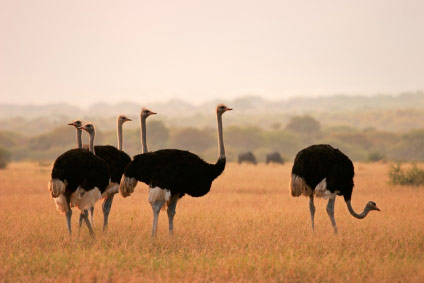Why Ostriches Can't Fly

The mass extinction that killed off dinosaurs might have been what grounded the ancestors of today's large flightless birds like the ostrich.
As the Age of Dinosaurs came to an end, some flying birds swooped in and took up the newly available niches, foraging on the ground, growing larger over the generations, and eventually losing the ability to fly. So suggests new research into the DNA of the birds.
Scientists had long thought the world's largest flightless birds, the ratites — which include African ostriches, Australasian emus, kiwis and cassowaries, South American rheas and the extinct New Zealand moas — shared a common flightless ancestor.
"Ratite birds have been thought of as relics of the former Gondwanan supercontinent, which combined Africa, South America, Australia, Antarctica, New Zealand, India and Madagascar," Phillips said.
However, it was then a puzzle as to how these flightless birds dispersed over the seas after Gondwana had largely broken up roughly 110 million years ago.
Genetic analysis in 2008 suggested that all these flightless birds actually shared a common flying ancestor. And new genetic research confirms that view and suggests a reason why the birds became grounded independently after dispersing geographically.
"Various ideas about hopping between temporary islands and now-sunken micro-continents are no longer necessary — the ancestors of all these birds could simply have flown," said researcher Matthew Phillips, an evolutionary biologist at the Australian National University in Canberra.
Sign up for the Live Science daily newsletter now
Get the world’s most fascinating discoveries delivered straight to your inbox.
Independently grounded
Phillips and his colleagues at Massey University in Palmerston North, New Zealand, analyzed the mitochondrial genome sequences of moas. To their surprise, the researchers found these extinct birds grouped most closely with the small flying tinamous of South America, rather than flocking with other ratites.
"I was analyzing DNA sequences for some of these ratites and kept coming up with the 'wrong' answers, which I ignored for a while, before doing the analyses more thoroughly and realizing that in fact, the evolutionary history of these birds was not how I and others had imagined it to be," he recalled.
Tinamous are one of the most ancient living groups of bird. They fly, but like quail and grouse, they dwell on the ground.
"Our study suggests that the flighted ancestors of ratites appear to have been ground-feeding birds that ran well," Phillips said.
Further analysis revealed that moas and tinamous are sister to a group that includes cassowaries and emus, while ostriches and rheas are more distantly related. Their findings suggest the ancestors of these ratite lineages each became flightless independently on different land masses some four to six times, at roughly the same time as the mass extinction that killed off dinosaurs about 65 million years ago.
The researchers conjecture that in order to escape the threat posed by predatory dinosaurs, the ancestors of ratites kept flying.
"So the extinction of the dinosaurs likely lifted predation pressures that had previously selected for flight and its necessary constraint, small size," Philips said. "Lifting of this pressure and more abundant foraging opportunities would then have selected for larger size and consequent loss of flight."
Why stop flying?
As to why birds might evolve to lose flight, "wings are a big drain on resources if not being used and larger birds are basically better at converting food into growth and reproduction," Phillips told LiveScience.
This growth in size and flightlessness enabled birds to fill some of the same niches their reptilian cousins once did. For instance, once so-called "terror birds" roamed the land, now-extinct predators with curved beaks as much as 18 inches long that, while flightless, were only distant relatives of ratites. The mass extinction also is what scientists think allowed the rise of larger mammals.
"The constraints we are able to place on linking the losses of flight to the extinction of dinosaurs are highly suggestive, but more precision is required for confirmation," Phillips cautioned. "There is an important role here for future fossil finds."
The scientists detailed their findings in the January issue of the journal Systematic Biology.
- Top 10 Useless Limbs (and Other Vestigial Organs)
- 10 Amazing Things You Didn’t Know About Animals
- Bird Study Reveals 10 Things You Didn't Know










